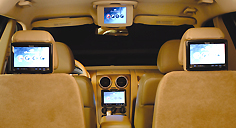As consumers have become increasingly connected to their consumer electronics, they've come to expect seamless connectivity in their vehicles. To meet these expectations, we're including an ever-increasing number of electronic modules supporting various features and functions in our vehicles.

Improving Vehicle Connectivity
As we look forward, we continue to look for ways to meet our customers' desires for connectivity while improving vehicle performance, reducing electrical complexity and controlling escalating electronics costs.
One solution could be Power Line Communication (PLC).
Complicated Wiring
Today's vehicles have more than 2,000 wires, which would measure more than a mile in length if you were to string them end-to-end.
If our engineers could reduce the complexity of those wires, they would be able to not only save money, but also possibly reduce the weight of a vehicle by more than 100 pounds through the elimination of wires, housings, shielding, connecters and fixture parts.
Looking for Answers at Home
As our engineers considered ways to make vehicles lighter, less expensive to build and easier to add or remove electronic components, they looked to advances in home connectivity and found Home Power Line Communications (HPLC) solving similar obstacles in the home.
At home, when you turn a light on or off or connect your computer to the internet, HPLC uses the copper power lines in your home to command, control and communicate information to your electronic devices.
HPLC has three advantages over competing connection methods:
1) It's simple—HPLC doesn't use a lot of wires
2) It's flexible—HPLC gives you the ability to add new electronics using existing power lines
3) It's powerful—With HPLC, power lines can be used for both low-bandwidth (simple switching on/off) and high bandwidth (video streaming and internet connectivity) features
HPLC is supported by a consortium called Home Plug Power Alliance and is gaining momentum in the consumer electronics marketplace, with many products commercially available at most electronics stores.
APLC: An Innovative Solution
Capturing the spirit of HPLC, our engineers are developing Automotive Power Line Communication (APLC) to deliver the connectivity consumers demand while also delivering maximized vehicle performance.
A typical automotive application of APLC might be to use a rear backup camera, which requires high-bandwidth communication for the video image, along with low-speed communication for turning the camera on and off. Use of APLC in this scenario would eliminate the need for a complicated and expensive wiring architecture. It's also incredibly flexible, allowing other devices to be easily added or adopted to meet consumers' changing needs.

